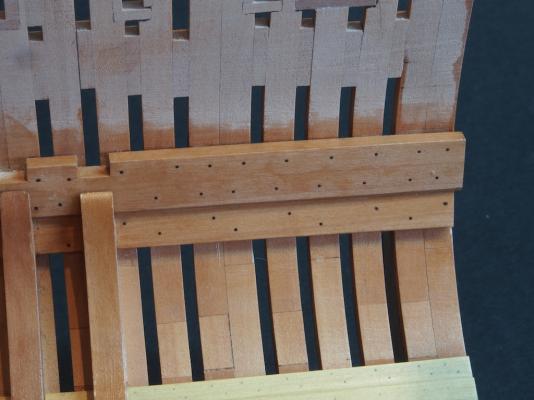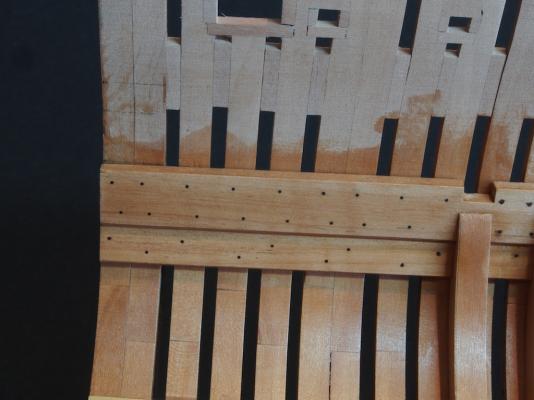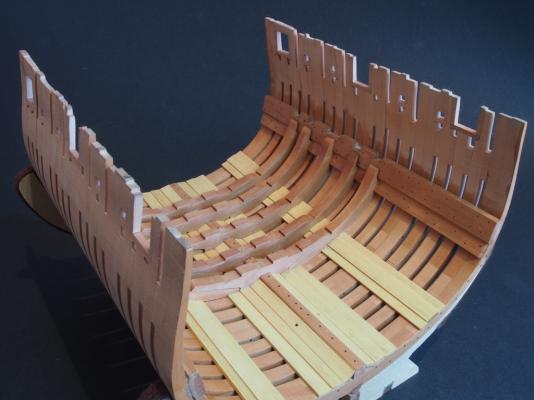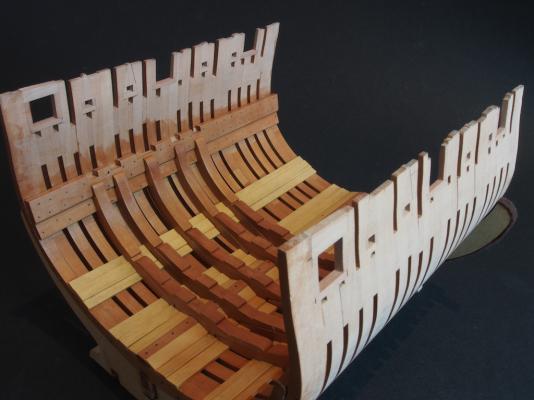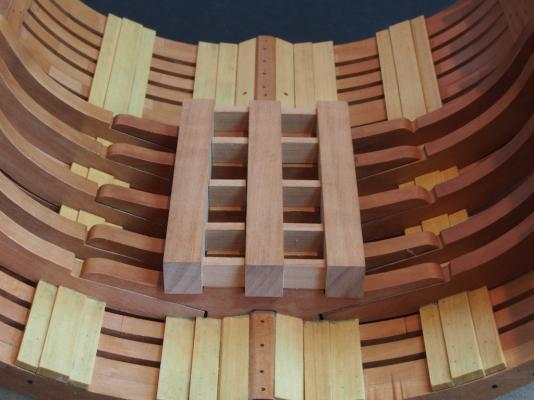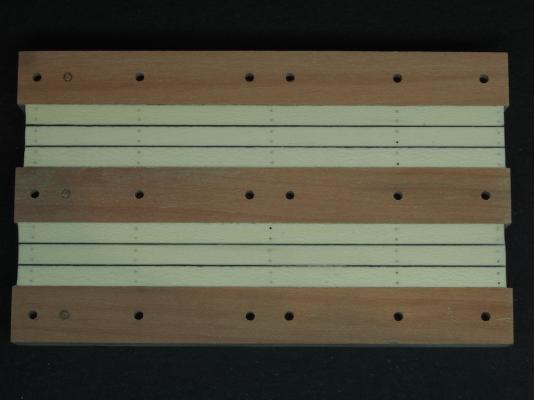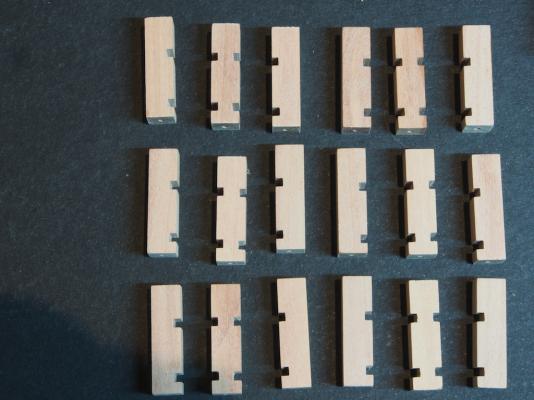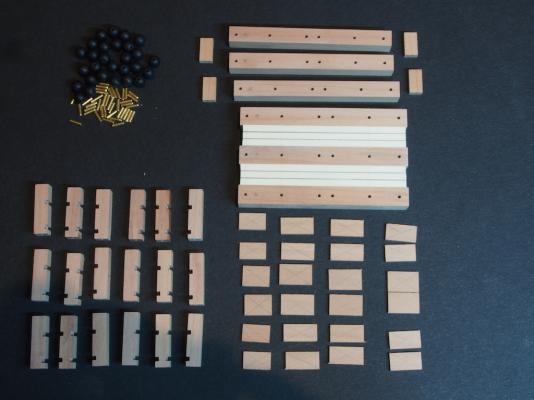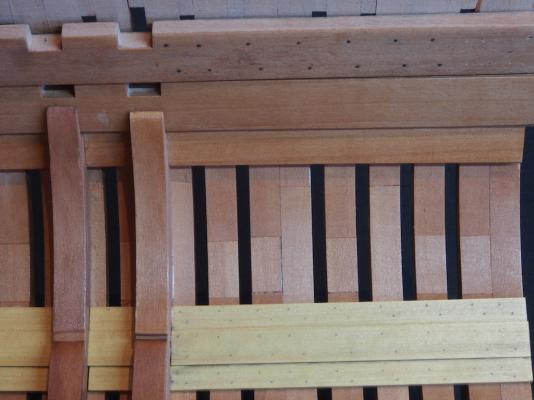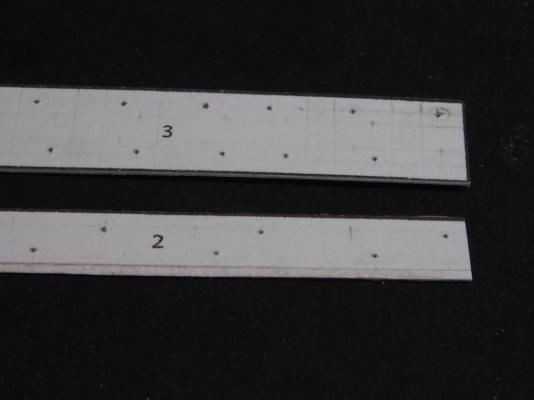-
Posts
4,880 -
Joined
-
Last visited
Content Type
Profiles
Forums
Gallery
Events
Everything posted by gjdale
-
Some more great work there Mobbsie - once again blazing the trail for the rest of the group coming along behind. Your other two builds might just slow you down enough for us to do a little catching up!
- 255 replies
-
- granado
- bomb ketch
-
(and 2 more)
Tagged with:
-
Ah! The problem with reality is that there's no background music............... Hope to see you back in the shipyard soon Andy.
- 382 replies
-
- stadacona
- sylvan scale models
-
(and 1 more)
Tagged with:
-
I've been away for the last couple of weeks, but did finally manage to get some shipyard time in this weekend. When last we met, I had decided to go ahead with the Deck Clamp Bolts. Here are a few pics of the final product – the pics appear somewhat streaky as the Wipe-on Poly was still wet when the pics were taken. With this job out of the way, it was time to make a start on construction of the Shell Room......... Shell Room Construction Construction of the Shell Room begins with the fitting of the lower support beams, made from 5/16” square Pear, across the Floor Riders, with cross beams added in situ to ensure a proper fit. Once the glue had dried, the frame assembly was removed from the model for further construction and fit-out. The next step was to install the deck planks. These are made from Holly, 1/16” x 1/8”. I opted to simulate caulking using black paper as I wanted to see how this would look, knowing that once the assembly was completed, this deck would hardly be visible. I also added treenails, using the drill and fill method as described previously. In the above photo, you may notice three filled holes towards the left hand end (one in each beam). This was where I incorrectly transferred one measurement before drilling. I have filled the incorrect holes with a mixture of Pear sawdust and diluted PVA. Once the assembly is complete, these will be barely visible, so I’m going to live with it. I've also just noticed that a couple of "treenails" in the Holly decking have come adrift and need replacing...... The pillars to support the shell racks were the next to be made. No particular rocket science here, but a great job for the Sherline Mill after cutting the blanks on the Byrnes saw. I constructed a small jig to hold all 18 pieces, then cut the dados (which are 2mm deep) in two passes of 1 mm each, using a 5/64” end mill cutter. The only issue I had in this job was caused by operator error when I failed to ensure that the cutter was securely held in the mill. The net result was that I destroyed half of my blanks in one pass. No biggie – just whipped up some more blanks on the Byrnes saw and replaced the duds. (Did I mention I love my Byrnes saw?.........and my Sherline Mill?) The pillars were also drilled in each end to take one end of a 1.5mm diameter brass locating pin (to match the holes drilled in the support beams). Finally, here is an overall shot of all the components of the shell room. The Shells themselves are ¼” diameter beads – they may be just a tad undersize, so I’m holding off on drilling out the shell racks until I find out whether I can source some slightly larger beads of the same type.
- 456 replies
-
- finished
- bomb ketch
-
(and 2 more)
Tagged with:
-
Nice work Ken - I just knew you'd be a natural in this medium!
- 440 replies
-
- niagara
- model shipways
-
(and 1 more)
Tagged with:
-
Great "how to" on the iron work Danny. And I guess a great "how to" on carving figureheads as well - ask Janos to do it! Seriously though, the figurehead looks great and is another example of this great community helping each other out. Kudos to Janos.
-
Lovely job on the yawl Ken. Looking forward to the next addition to the miniature fleet.
- 440 replies
-
- niagara
- model shipways
-
(and 1 more)
Tagged with:
-
You're off to a great start Ken - no surprise here!
- 440 replies
-
- niagara
- model shipways
-
(and 1 more)
Tagged with:
-
Lovely work Mobbsie. I can't wait to get back to the shipyard to catch up.
- 255 replies
-
- granado
- bomb ketch
-
(and 2 more)
Tagged with:
-
Just lovely Bob. Up to your usual high standard I see!
- 1,477 replies
-
- essex
- model shipways
-
(and 1 more)
Tagged with:
-
Hey Jack, I sent that last one while having breakfast. My morning ritual - breakfast while reading the latest on MSW. It doesn't get much better than this!
- 60 replies
-
- granado
- bomb ketch
-
(and 1 more)
Tagged with:
-
Very nice indeed Sjors - you'll be in the rigging in no time!
- 1,616 replies
-
- caldercraft
- agamemnon
-
(and 1 more)
Tagged with:
-
That's looking just fantastic Jack - well done mate!
- 60 replies
-
- granado
- bomb ketch
-
(and 1 more)
Tagged with:
-
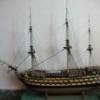
Blacken Brass
gjdale replied to sailor jim's topic in Discussion for a Ship's Deck Furniture, Guns, boats and other Fittings
Thanks for the correction fellas. -

Blacken Brass
gjdale replied to sailor jim's topic in Discussion for a Ship's Deck Furniture, Guns, boats and other Fittings
Keith, I'm no expert and would be happy to stand corrected on this. -

Blacken Brass
gjdale replied to sailor jim's topic in Discussion for a Ship's Deck Furniture, Guns, boats and other Fittings
Jim, Liver of Sulphur (LoS) will not blacken brass. It is great for using on copper, and has the distinct advantage of being able to be applied in situ on the model, with the excess being washed off and not effecting the surrounding timber. For brass you need a different solution. Birchwood Casey Brass Black is a good choice for this and can be found at most gunsmith supply shops. This, however, cannot be applied in situ on the model. For either brass or copper, you need to ensure that any protective film is removed (fine sandpaper is good for this) and that the parts are thoroughly cleaned before blackening using either white vinegar (muriatic acid), or acetone. -
Thanks guys, Mobbsie has posted a little bit of research on his log, dug up for us by Wayne, that suggests the use of "nails". And I agree with Mobbsie's rationale of the weight/shock factors requiring extra strength - at least it makes sense to me...... .....which is a roundabout way of saying, I'm going to go ahead as previously described and shown in my test piece! Mobbsie - your definition of being "behind" is, shall we say, questionable?!!! Knowing you, you'll have the shell room finished by tomorrow evening! I'll be away for a couple of weeks coming up, so it may be a while before another update.
- 456 replies
-
- finished
- bomb ketch
-
(and 2 more)
Tagged with:
-
Mark's post suggests to me that perhaps there is plenty of room for "interpretation" here. So, I've gone ahead and prepared a test piece using a "spare" Mortar Pit Deck Clamp. This has used 0.5mm Copper Wire, using the template I showed earlier, then sanded back, blackened with LoS, and then one coat of Wipe-on Poly applied. I've just placed it on the model to get an idea of what it will look like in situ. In the picture, you can see the treenails in the planking below as a comparison. Pay no attention to the light coloured "dots" on the right hand end of the test piece - they were from earlier treenail tests. I think this is looking okay - not overdone. Grateful for any and all opinions/comments.
- 456 replies
-
- finished
- bomb ketch
-
(and 2 more)
Tagged with:
-
Thanks Mark, That actually IS quite helpful - it shows that either/any approach could be considered "correct".
- 456 replies
-
- finished
- bomb ketch
-
(and 2 more)
Tagged with:
-
Thanks everyone for all the kind comments and the likes. I have a dilemma and am hoping that some of you knowledgeable folk can help me...... I had assumed that the Deck Clamps would be secured in place with a system of iron bolts. However, I can find no specific reference for this. I have checked through AOTS, TFFM and EdT's Naiad books and unless I'm reading right past it, I can't find a reference anywhere to guide me in this. Would they be bolted or treenailed? If bolted, what is the appropriate size? What bolting pattern would be used? What I've come up with so far, all assumption I might add, is that the bolts would be no more than 1" diameter (full size), which scales to about 0.5mm for this build. That "feels" about right, when compared to the 0.8mm bolts used in the frames and keelson. As far as patterns go, I am making an assumption that there would be at least one bolt in each frame, and two for the wider clamps. In this instance, the Mortar Pit Deck Clamp (Upper) is 24" wide (full size) and looks to be wide enough to have two bolts per frame, while it's partner (MPDC Lower) is 15" wide (full size) and looks about right for one bolt per frame, but in a staggered pattern. I've made up some templates for the bolting pattern described above. Before I commit to this, I'd love to hear any and all advice.
- 456 replies
-
- finished
- bomb ketch
-
(and 2 more)
Tagged with:
About us
Modelshipworld - Advancing Ship Modeling through Research
SSL Secured
Your security is important for us so this Website is SSL-Secured
NRG Mailing Address
Nautical Research Guild
237 South Lincoln Street
Westmont IL, 60559-1917
Model Ship World ® and the MSW logo are Registered Trademarks, and belong to the Nautical Research Guild (United States Patent and Trademark Office: No. 6,929,264 & No. 6,929,274, registered Dec. 20, 2022)
Helpful Links
About the NRG
If you enjoy building ship models that are historically accurate as well as beautiful, then The Nautical Research Guild (NRG) is just right for you.
The Guild is a non-profit educational organization whose mission is to “Advance Ship Modeling Through Research”. We provide support to our members in their efforts to raise the quality of their model ships.
The Nautical Research Guild has published our world-renowned quarterly magazine, The Nautical Research Journal, since 1955. The pages of the Journal are full of articles by accomplished ship modelers who show you how they create those exquisite details on their models, and by maritime historians who show you the correct details to build. The Journal is available in both print and digital editions. Go to the NRG web site (www.thenrg.org) to download a complimentary digital copy of the Journal. The NRG also publishes plan sets, books and compilations of back issues of the Journal and the former Ships in Scale and Model Ship Builder magazines.



